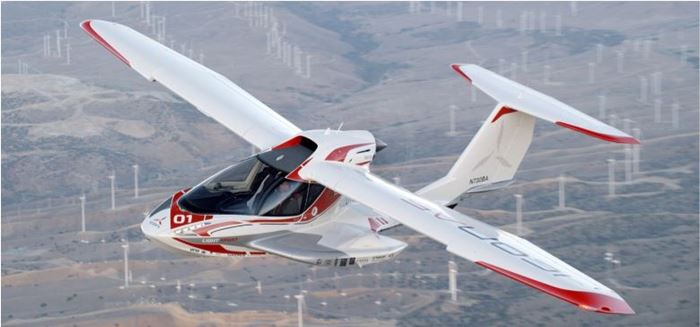ICON Aircraft constructs and flies first production A5
Amphibious light sport aircraft features carbon fiber composite construction; first model to be made using production tooling and components unveiled at OshKosh.
ICON Aircraft (Los Angeles, Calif., USA) unveiled the first production A5 — an amphibious light sport aircraft made from carbon fiber composites — at the 2014 EAA AirVenture in Oshkosh, Wisconsin. Referred to as Engineering Serial Number 1 (ESN·1), this is the first A5 built from the production design, with production tooling, and using production methods and components. ESN-1 was built over a five-month period, from January to June of 2014, and successfully completed its first flight on 7 July 2014 in Tehachapi, California. This aircraft is one of three that will be used to verify performance and complete FAA approval prior to the start of customer deliveries in May 2015.
"This is one of the most significant milestones to date for ICON. It represents the culmination of years of research, design, engineering, and manufacturing dedication by an outstanding team," said ICON Aircraft Founder and CEO Kirk Hawkins. "The A5 is no longer a prototype or concept aircraft. It's a sophisticated, production-ready, consumer-focused aircraft. The entire ICON team is pouring its heart and soul into bringing the A5 to our customers, and it shows in the truly exceptional execution of the product. I couldn't be prouder."
"The A5's development has been a massive undertaking," said ICON VP of Engineering and CEO Matthew Gionta. "The amount of intellectual horsepower and years of relentless commitment that has gone into this aircraft is impressive. The ICON team worked tirelessly to make the A5 a reality; it is difficult to convey the magnitude of work involved to bring a new aircraft to market, much less one balancing all the demanding design requirements of the A5. Before we could even begin designing the aircraft's 1600-plus unique components, the team spent thousands of hours designing, building, testing, and iterating the proof of concept aircraft to get it right. Only then could we design the production parts, the tools to manufacture them, and work with the 100 or so suppliers that are contributing components to the A5," explained Gionta. "With ESN-1 complete and ESN-2 under construction, we are now looking toward FAA approval, after which we will begin customer deliveries. I can't wait for our customers to finally experience the finished product."
ESN-1 was built at ICON's facility in Tehachapi, California, and made its first flight from the Tehachapi Municipal Airport earlier this month. "ESN-1 performed very well on its first flight," said ICON Test Pilot and Lead Aero Engineer Jon Karkow, who was at the controls for the flight. "Its flight characteristics are similar to the proof of concept aircraft, which logged over 700 flights, with the same responsive character and control harmony. The hard work of the engineering and production teams is very clear."
A second production prototype, ESN-2, is currently under construction and is scheduled for completion and structural testing this fall. The first three aircraft built will support the FAA approval process, and the third aircraft will be delivered to the first customer after that process is complete.
ICON recently announced that it would begin operating in its new 140,000 ft2 facility in
Vacaville, California in early 2015. The company is currently readying the factory and offices to begin full-scale manufacturing. Once at full production rates, the factory will be capable of producing more than 500 aircraft per year.
Related Content
Plant tour: Joby Aviation, Marina, Calif., U.S.
As the advanced air mobility market begins to take shape, market leader Joby Aviation works to industrialize composites manufacturing for its first-generation, composites-intensive, all-electric air taxi.
Read MoreWelding is not bonding
Discussion of the issues in our understanding of thermoplastic composite welded structures and certification of the latest materials and welding technologies for future airframes.
Read MoreA new era for ceramic matrix composites
CMC is expanding, with new fiber production in Europe, faster processes and higher temperature materials enabling applications for industry, hypersonics and New Space.
Read MorePEEK vs. PEKK vs. PAEK and continuous compression molding
Suppliers of thermoplastics and carbon fiber chime in regarding PEEK vs. PEKK, and now PAEK, as well as in-situ consolidation — the supply chain for thermoplastic tape composites continues to evolve.
Read MoreRead Next
All-recycled, needle-punched nonwoven CFRP slashes carbon footprint of Formula 2 seat
Dallara and Tenowo collaborate to produce a race-ready Formula 2 seat using recycled carbon fiber, reducing CO2 emissions by 97.5% compared to virgin materials.
Read MorePlant tour: Daher Shap’in TechCenter and composites production plant, Saint-Aignan-de-Grandlieu, France
Co-located R&D and production advance OOA thermosets, thermoplastics, welding, recycling and digital technologies for faster processing and certification of lighter, more sustainable composites.
Read More“Structured air” TPS safeguards composite structures
Powered by an 85% air/15% pure polyimide aerogel, Blueshift’s novel material system protects structures during transient thermal events from -200°C to beyond 2400°C for rockets, battery boxes and more.
Read More



























